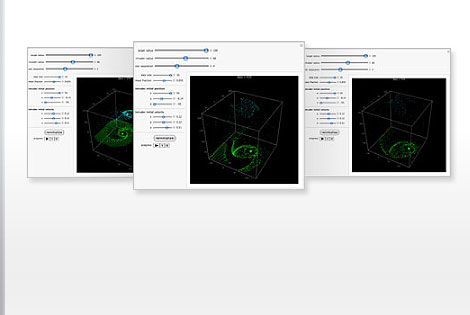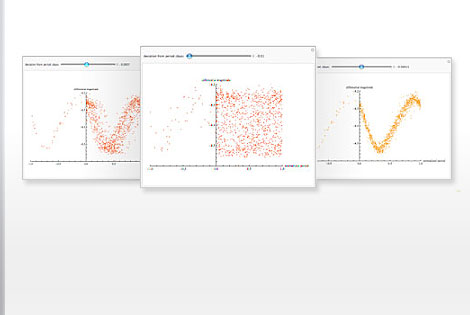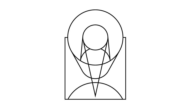The Wolfram Solution forAstronomyCompute positions of astronomical objects in real time, building models, analyzing data, and instantly creating interactive visualizations—all in one system with one integrated workflow. The Wolfram astronomy solution combines sophisticated data analysis capabilities, world-class image processing, and highly optimized differential equation solving with built-in parallel computing and 64-bit technology. |
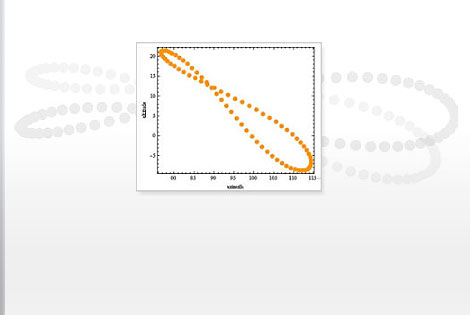 |
Wolfram technologies include thousands of built-in functions and curated data on many topics that let you:
- Do mathematical modeling to study galaxy formation, stellar dynamics, and other topics
- Perform image processing of astronomical objects
- Use built-in astronomy data for real-time computation of positions of astronomical objects
- Perform sophisticated data analysis and optimization routines for astrophysical modeling
- Plot orbits of planets, exoplanets, stars, and other astronomical bodies using built-in astronomical data
- Perform spectral analysis of irregularly sampled time-series data
- Model particle trajectories
- Compute the rise times of stars and planets through the year
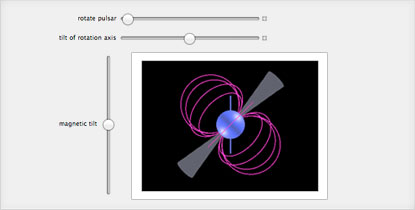
Modeling and interactively exploring a pulsar
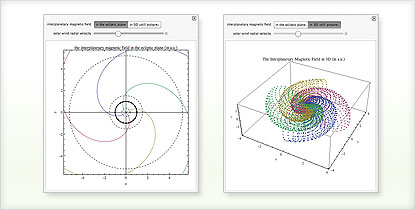
Plotting the interplanetary magnetic field (Parker spiral)
Does your current tool set have these advantages?
-
Free-form linguistic input produces immediate results without the need for syntax
Unique to Wolfram technologies -
Built-in astronomy data for real-time dynamic computation of astronomical object positions
Unique to Wolfram technologies -
Automatic interface construction to interactively visualize your simulations, examine model sensitivity to parameter changes, and more
Unique to Wolfram technologies -
Tight integration of the core Mathematica system with more than 20 built-in application areas such as image processing, GIS, statistics, and more
Matlab requires multiple extra-cost toolboxes -
Powerful symbolic statistical computation and data analysis using built-in functions
R, STATA, and other numerical systems do not have integrated symbolic functionality -
Fully automated precision control and arbitrary-precision arithmetic produce accurate results
All systems relying on finite precision arithmetic, such as Excel or Matlab, can cause errors due to lack of precision - Seamless integration of numerics, symbolics, interactive graphics, and all other computational aspects in one system

Modeling mass transfer in binary star systems

Modeling light curves of objects too far away to study with optical telescopes
Astronomy specific capabilities:
- Built-in data on planets, exoplanets, stars, galaxies, and other astronomical entities »
- Sophisticated data analysis and optimization routines for astrophysical modeling »
- Automatic interface construction to interactively analyze your models »
- Fast numerical linear algebra operations and high-performance sparse linear algebra routines enable efficient large-scale data computations »
- State-of-the-art image processing capabilities for astronomical imaging tasks »
- Free-form linguistic input produces immediate results without the need for syntax »
- Advanced 2D and 3D graphics, including texture mapping and fast 3D rendering for graphics with transparency »
- Import and export of all common data formats, including FITS, HDF5, TeX, PDF, KML, and more »
- High-performance computing using a combination of multicore computing, 64-bit technology, and built-in parallel processing
- Built-in data on all classes of astronomical entities, including planets, exoplanets, stars, galaxies, and more »
- Built-in connectivity to databases, web services, existing C++ code, other commercial programs, and Java and .NET frameworks »
- World's best symbolic and numeric equation solvers, along with industry-leading sets of special functions and algorithms »
- Input, output, and computation with traditional mathematical notation
- Instantly deploy your interactive models using Wolfram CDF Player or webMathematica

